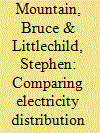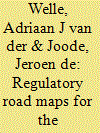| Srl | Item |
| 1 |
ID:
098623


|
|
|
|
|
| Publication |
2010.
|
| Summary/Abstract |
A decade ago, electricity distribution network revenues per customer in New South Wales (NSW) were twice those in Great Britain (GB). Recent price controls imply that by 2014 they will be nearly four times as high. This paper examines possible reasons for this. The main reason does not seem to be geography, operating environment or industry structure. GB and Victoria have managed to accommodate increasing demand at broadly constant or even declining costs and revenues while delivering higher quality of service, while NSW has not. The regulatory framework and the practice of the regulatory body within that framework seem relevant. Australian regulators have not used benchmarking techniques as the GB regulator has. Perhaps the most important explanatory factor is private ownership in GB and Victoria compared to state ownership in NSW. This could also impact on the nature and effectiveness of regulation.
|
|
|
|
|
|
|
|
|
|
|
|
|
|
|
|
| 2 |
ID:
169882


|
|
|
|
|
| Summary/Abstract |
Several studies have investigated large scale renewables, electricity networks and the potential for a supergrid, both in the US and the Europe. However, much of this work is focused on technical and economic barriers and under-recognises social, political and other non-technical aspects. This paper builds a conceptual framework to analyse the non-technical barriers, engagement of stakeholders and social risks to the proposed supergrids in the US and Europe. In doing so, we find 12 different non-technical situations (barriers) on each region that are present in the implementation of a supergrid, and can help guide the development of these economically efficient projects to address the social barriers and risks that they may face. From our results, we suggest a set of policy recommendations, parting with the introduction of an overarching body of governance for the coordination and implementation of the supergrid. This, we hope, provides a map and encouragement for policymakers, investors and stakeholders looking to develop and complete these megaprojects; recognising that some configuration of a supergrid is required to achieve a full penetration of renewables. Therefore, the results of this paper have a significant contribution in decarbonising energy production and supply systems, complying with national and international climate ambitions.
|
|
|
|
|
|
|
|
|
|
|
|
|
|
|
|
| 3 |
ID:
109614


|
|
|
|
|
| Publication |
2011.
|
| Summary/Abstract |
The envisaged increase in the share of electricity generation from intermittent renewable energy sources (RES-E) like wind and photovoltaics will pose challenges to the existing electricity system. A successful integration of these sources requires a cost-efficient use of system flexibility. The literature on the options to improve system flexibility, and thus the costs of successfully integrating intermittent electricity generating units, is still growing but what is lacking is an overarching systematic view on when to adopt which option in particular energy systems. This paper aims to bridge this gap in literature. We use existing insights on market and network integration of intermittent electricity sources within a regulatory road map framework. The framework allows policy makers and other electricity system stakeholders to arrive at a consistent strategy in dealing with integration issues over a longer period of time. In this contribution we present and explain the framework and apply it for the case of The Netherlands.
|
|
|
|
|
|
|
|
|
|
|
|
|
|
|
|